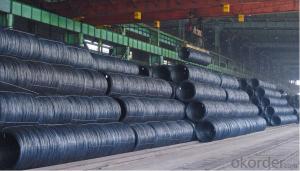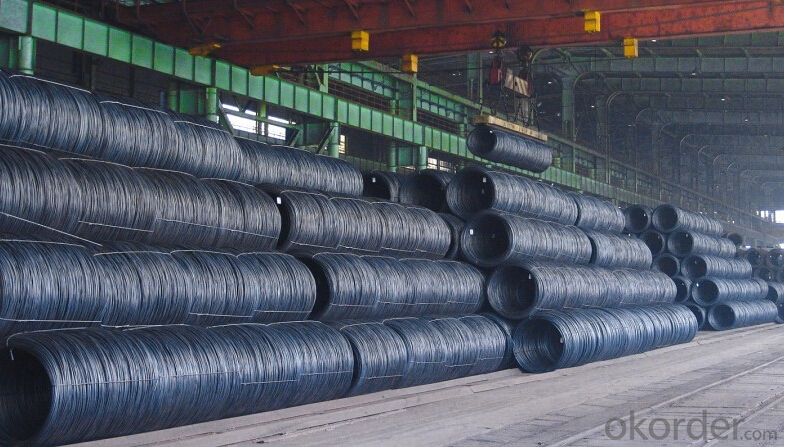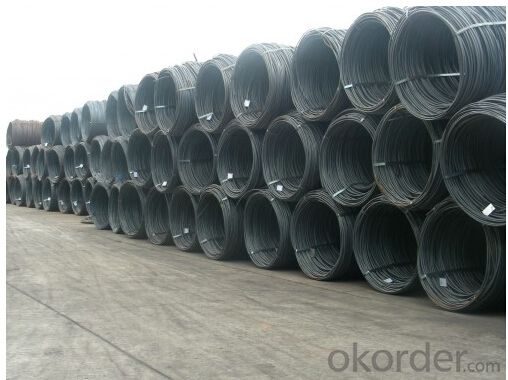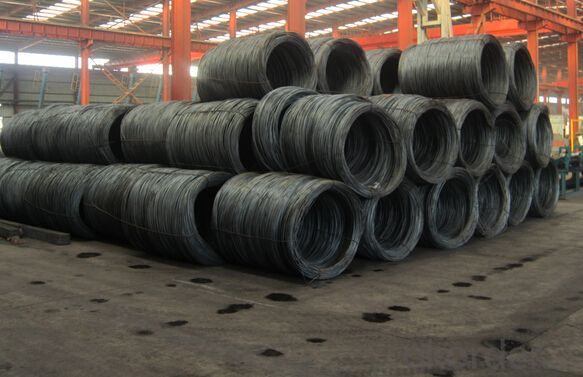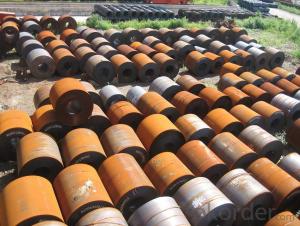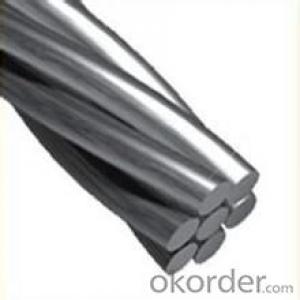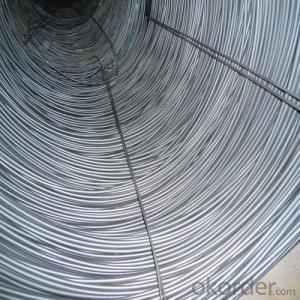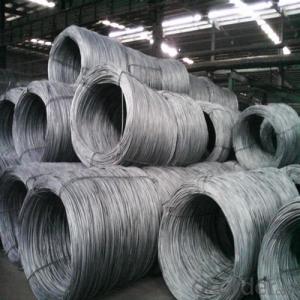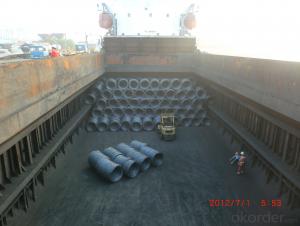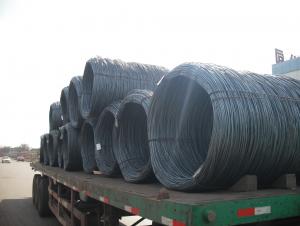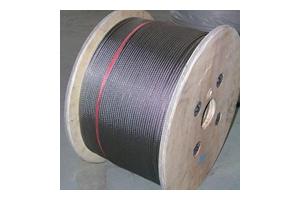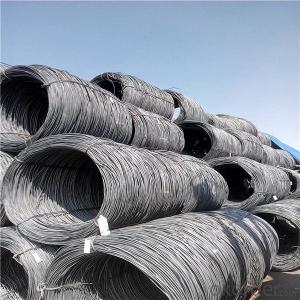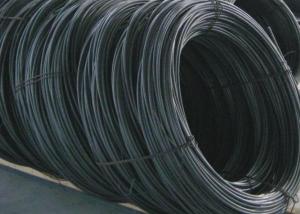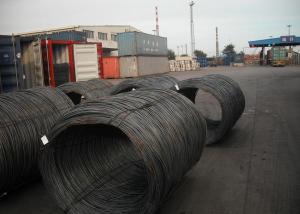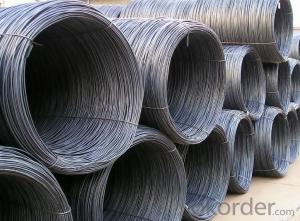HIGH QUALITY WIRE ROD
- Loading Port:
- China Main Port
- Payment Terms:
- TT OR LC
- Min Order Qty:
- -
- Supply Capability:
- -
OKorder Service Pledge
Quality Product, Order Online Tracking, Timely Delivery
OKorder Financial Service
Credit Rating, Credit Services, Credit Purchasing
You Might Also Like
Quick Details
| Place of Origin: | Brand Name: | Model Number: | |||
| Material: | white: |
Packaging & Delivery
| Packaging Detail: | the package of the wire rod steel for construction is standard exporting package |
| Delivery Detail: | 30d upon recipt of L/C |
Specifications
the wire rod steel for construction that we offer have been used in civil construction work for years.
SPECIFICATION
1: WIRE ROD IN COIL
2. STANDARD: AISI,ASTM,BS,DIN,GB,JIS
3. STEEL GRAD: Q195--235/SAE1006B/SAE1008B/SA31012B/SDA31015B/SA31018B/SA31022B
4. SIZE: 5--22MM

1) the products that we offer haven been used in civil constrction work for years
2) meet different requirment
3) we can offer accordingly with different demands
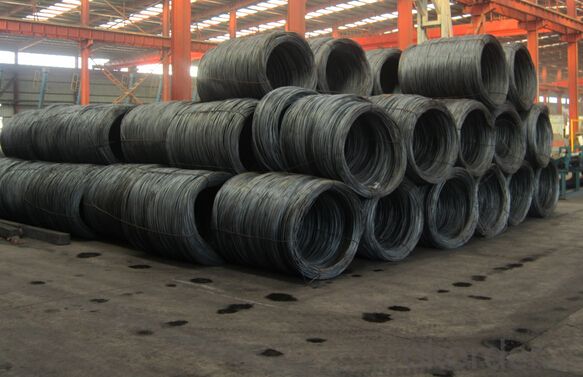
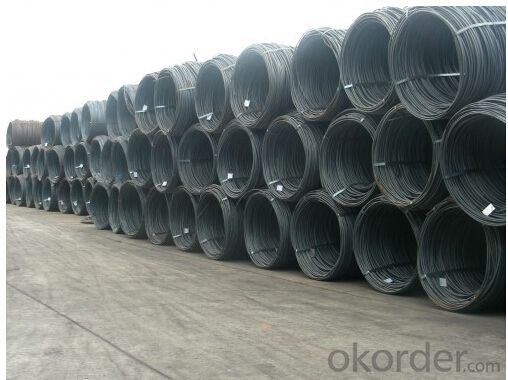
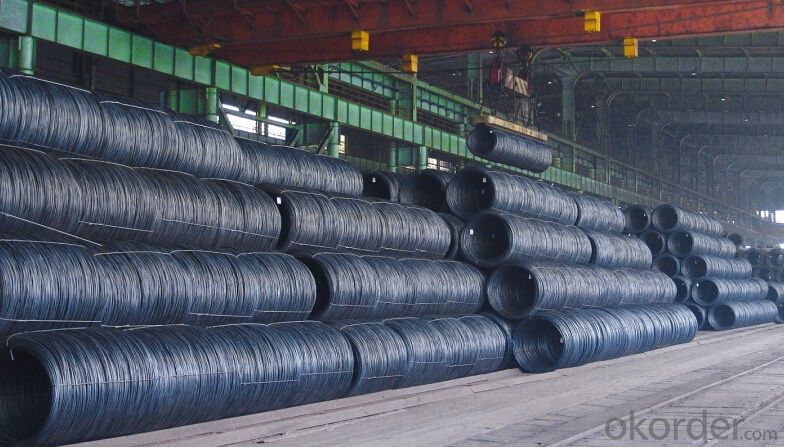
- Q: What are the different types of heat treatment processes for steel wire rod?
- There are several different types of heat treatment processes that can be used for steel wire rod, each offering unique benefits and properties to the material. 1. Annealing: This process involves heating the steel wire rod to a specific temperature and then slowly cooling it down. Annealing helps to improve the ductility and toughness of the material, making it easier to form and shape. 2. Quenching and tempering: This process involves heating the steel wire rod to a high temperature and then rapidly cooling it, known as quenching. This helps to harden the material and make it stronger. After quenching, the wire rod is then tempered by reheating it to a lower temperature, which helps to reduce brittleness and improve toughness. 3. Normalizing: Similar to annealing, normalizing involves heating the steel wire rod to a specific temperature and then cooling it in still air. This process helps to refine the grain structure of the material, improving its strength and machinability. 4. Stress relieving: This process involves heating the steel wire rod to a specific temperature and then slowly cooling it. The purpose of stress relieving is to reduce internal stresses that may have been caused by previous manufacturing processes, such as cold working or welding. This helps to improve the dimensional stability and reduce the risk of distortion during subsequent processing or use. 5. Case hardening: Also known as carburizing, this process involves introducing carbon into the surface layer of the steel wire rod to increase its hardness. This is typically achieved by heating the wire rod in a carbon-rich atmosphere, such as with a gas or a solid medium. Case hardening creates a hard outer layer, while maintaining a softer and more ductile core, providing a combination of wear resistance and toughness. Each of these heat treatment processes can be tailored to achieve specific material properties based on the desired application. The choice of process depends on factors such as the desired hardness, strength, toughness, and machinability of the steel wire rod.
- Q: What are the main factors affecting the toughness of steel wire rod?
- The main factors affecting the toughness of steel wire rod include the composition of the steel, the heat treatment process, the presence of impurities or defects, and the wire rod's microstructure.
- Q: How is the dimensional accuracy of steel wire rod measured?
- The dimensional accuracy of steel wire rod is typically measured using various techniques and tools to ensure that the dimensions of the rod meet the required specifications. Some commonly used methods to measure the dimensional accuracy of steel wire rod include: 1. Calipers: Calipers are used to measure the diameter of the steel wire rod. They can be either manual or digital, and they provide accurate readings by tightly gripping the rod and measuring its diameter. 2. Micrometers: Micrometers are precise measuring tools used to measure the diameter of the steel wire rod. They provide highly accurate readings by using a calibrated screw mechanism to measure the dimensions. 3. Optical measurement systems: Optical measurement systems use advanced technology, such as lasers or cameras, to measure the dimensions of the steel wire rod. These systems provide accurate and quick measurements by capturing multiple data points and analyzing them to determine the dimensional accuracy. 4. Ultrasonic measurement: Ultrasonic measurement techniques involve emitting ultrasonic waves into the steel wire rod and analyzing the reflected waves to determine its dimensions. This method is especially useful for measuring the thickness and cross-sectional dimensions of the rod. 5. Automated measurement systems: Automated measurement systems utilize specialized equipment and software to measure the dimensional accuracy of steel wire rods. These systems can provide accurate and repeatable measurements by employing robotics, sensors, and image processing algorithms. It is important to note that the specific measurement technique used may vary depending on the required dimensions, tolerances, and the capabilities of the manufacturer or testing facility.
- Q: What are the different packaging options for steel wire rod?
- The different packaging options for steel wire rod include coils, spools, bundles, and crates.
- Q: How is steel wire rod used in the manufacturing of reinforcing bars?
- Rebar, also known as reinforcing bars, is manufactured using steel wire rod. This essential component is widely used in the construction industry to enhance the strength and durability of concrete structures. The manufacturing process of reinforcing bars involves several steps. Initially, the wire rod is cleansed to eliminate impurities and contaminants. It is then heated and passed through a series of rollers to achieve the desired diameter and shape, a process known as hot rolling. Once the wire rod is shaped, it undergoes cooling and a process called quenching and tempering. This involves rapidly cooling the steel to increase its hardness and strength, followed by tempering to decrease brittleness and improve toughness. This heat treatment procedure ensures that the reinforcing bars possess the necessary mechanical properties to withstand the forces and stresses they will encounter during construction. After shaping and heat treatment, the wire rod is cut into specific lengths to produce individual reinforcing bars. These bars can be further processed by fabrication into various shapes, such as straight bars, bent bars, or stirrups. Alternatively, they can undergo threading or welding, depending on the specific requirements of the construction project. The utilization of steel wire rod in the manufacturing of reinforcing bars is vital as it provides the strength and structural integrity needed to reinforce concrete structures. The wire rod's high tensile strength enables the reinforcing bars to resist forces such as tension, compression, and bending, thereby enhancing the overall strength and stability of concrete structures. Furthermore, the wire rod's ductility and toughness contribute to the rebar's ability to absorb and distribute stress, preventing cracks and failures in the concrete. In conclusion, steel wire rod plays a crucial role in the manufacturing of reinforcing bars. Through shaping, heat treatment, and fabrication, it ensures that the resulting reinforcing bars possess the required strength, durability, and mechanical properties to effectively reinforce concrete structures.
- Q: How is steel wire rod used in the manufacturing of wire for automotive braking systems?
- The manufacturing of wire for automotive braking systems heavily relies on steel wire rod. This crucial component possesses remarkable strength and durability. To create the wire used in these systems, a series of manufacturing processes are implemented after carefully selecting high-quality steel wire rod. To begin with, the steel wire rod undergoes thorough examination and testing to ensure it meets the required specifications and standards for automotive braking systems. This step is of utmost importance as the wire must withstand the immense forces and pressures exerted during braking, guaranteeing the safety and reliability of the braking system. Once the steel wire rod successfully passes the quality tests, it proceeds to a process known as wire drawing. This process involves pulling the steel wire rod through a series of dies, gradually reducing its diameter while increasing its length. As a result, a wire with a smooth and uniform surface is obtained, enhancing its ability to resist wear and corrosion. Following wire drawing, the wire undergoes further processing through heat treatment. This involves subjecting the wire to controlled heating and cooling processes, such as annealing or quenching, to enhance its mechanical properties. Through heat treatment, the wire's tensile strength, hardness, and resistance to deformation are increased, making it suitable for the demanding conditions of automotive braking systems. Afterward, the wire is coated with a protective layer, typically made of zinc or other corrosion-resistant materials, through the process of galvanization. This coating provides an additional layer of protection against rust and corrosion, extending the wire's lifespan and ensuring its optimal performance in harsh environments. Finally, the wire undergoes additional processing to meet the specific requirements of automotive braking systems. It may be shaped, cut, or formed into various components such as brake cables, brake pads, or brake springs. The exceptional strength, durability, and reliability of the steel wire rod used in the manufacturing of wire for automotive braking systems greatly contribute to the overall performance and safety of the braking system. In conclusion, the role of steel wire rod in the manufacturing of wire for automotive braking systems is vital. Its exceptional strength, durability, resistance to wear and corrosion make it the ideal material for withstanding the extreme forces and conditions experienced during braking. By utilizing high-quality steel wire rod, automotive manufacturers can ensure the production of reliable and safe braking systems.
- Q: How is steel wire rod used in the manufacturing of barbed wire?
- Steel wire rod is a crucial component in the manufacturing of barbed wire as it serves as the base material for creating the barbs. The steel wire rod is first drawn into thin wires, which are then twisted and shaped into sharp points or barbs. These barbs are then attached to a central wire, forming the characteristic barbed wire structure. This process ensures that barbed wire is strong, durable, and effective for various applications such as security fencing, livestock containment, and military purposes.
- Q: How is steel wire rod used in the production of wire mesh conveyor belts?
- Steel wire rod is an essential component in the production of wire mesh conveyor belts. These belts are commonly used in industries such as food processing, mining, and automotive manufacturing. The steel wire rod is first processed through a series of machines to form wires of the desired thickness and strength. Once the wires are formed, they are woven together to create a mesh pattern. The steel wire rod provides the necessary strength and durability to withstand heavy loads and high temperatures typically encountered in conveyor belt applications. Additionally, the steel wire rod's flexibility allows the mesh to be easily bent and shaped to fit various conveyor belt configurations. The wire mesh conveyor belts offer several advantages over traditional conveyor belts made from other materials. The open mesh design allows for better airflow and drainage, making them ideal for applications that involve heat or liquids. They also provide excellent strength-to-weight ratio, ensuring long-lasting performance and reducing maintenance costs. Moreover, the steel wire rod used in wire mesh conveyor belts can be coated with materials such as PVC or galvanized to enhance its corrosion resistance. This further extends the lifespan of the conveyor belt, making it suitable for use in harsh environments or industries where corrosive substances are present. In summary, steel wire rod is a crucial component in the production of wire mesh conveyor belts. Its strength, durability, and flexibility make it ideal for withstanding heavy loads, high temperatures, and corrosive environments. These belts offer several advantages over traditional conveyor belts, making them a popular choice in various industries.
- Q: What are the main factors influencing the choice of steel wire rod order storage tracking options?
- The main factors influencing the choice of steel wire rod order storage tracking options include the size and complexity of the inventory, the level of automation in the storage facility, the frequency of order retrieval and replenishment, the need for real-time visibility and accuracy in tracking, and the overall cost and efficiency of implementing different tracking systems.
- Q: How are steel wire rods used in the manufacturing of fasteners?
- Steel wire rods are an essential component in the manufacturing of fasteners. Fasteners, such as bolts, screws, and nails, are used to join or secure two or more objects together. Steel wire rods serve as the raw material for fasteners, providing the necessary strength and durability. The manufacturing process begins with steel wire rods, which are usually made from carbon or alloy steel. These rods are typically produced through a hot rolling process, where the steel is heated and then passed through a series of rollers to achieve the desired shape and size. The resulting wire rods are then further processed to meet the specific requirements of fastener production. One of the primary uses of steel wire rods in fastener manufacturing is for the production of bolts and screws. The wire rods are typically cut into specific lengths and then undergo a series of operations, such as heading, threading, and heat treatment. Heading involves forming the head of the bolt or screw, while threading creates the ridges or grooves that allow them to be screwed into place. Heat treatment is often employed to enhance the strength and hardness of the fastener. Steel wire rods are also used in the production of nails. The rods are first drawn to the desired diameter and then cut into appropriate lengths. The ends of the wire are sharpened, and the nails are formed by a process called pointing. Pointing involves creating a sharp tip on one end of the wire, which allows the nail to penetrate materials easily. In addition to bolts, screws, and nails, steel wire rods are used in the manufacturing of other fasteners, such as rivets, cotter pins, and clips. These fasteners are essential in various industries, including construction, automotive, aerospace, and furniture. Overall, steel wire rods play a crucial role in the manufacturing of fasteners by providing the necessary strength, durability, and versatility required for joining and securing objects together. They serve as the foundation for the production of various fastener types, enabling the construction of strong and reliable structures.
Send your message to us
HIGH QUALITY WIRE ROD
- Loading Port:
- China Main Port
- Payment Terms:
- TT OR LC
- Min Order Qty:
- -
- Supply Capability:
- -
OKorder Service Pledge
Quality Product, Order Online Tracking, Timely Delivery
OKorder Financial Service
Credit Rating, Credit Services, Credit Purchasing
Similar products
Hot products
Hot Searches
Related keywords
